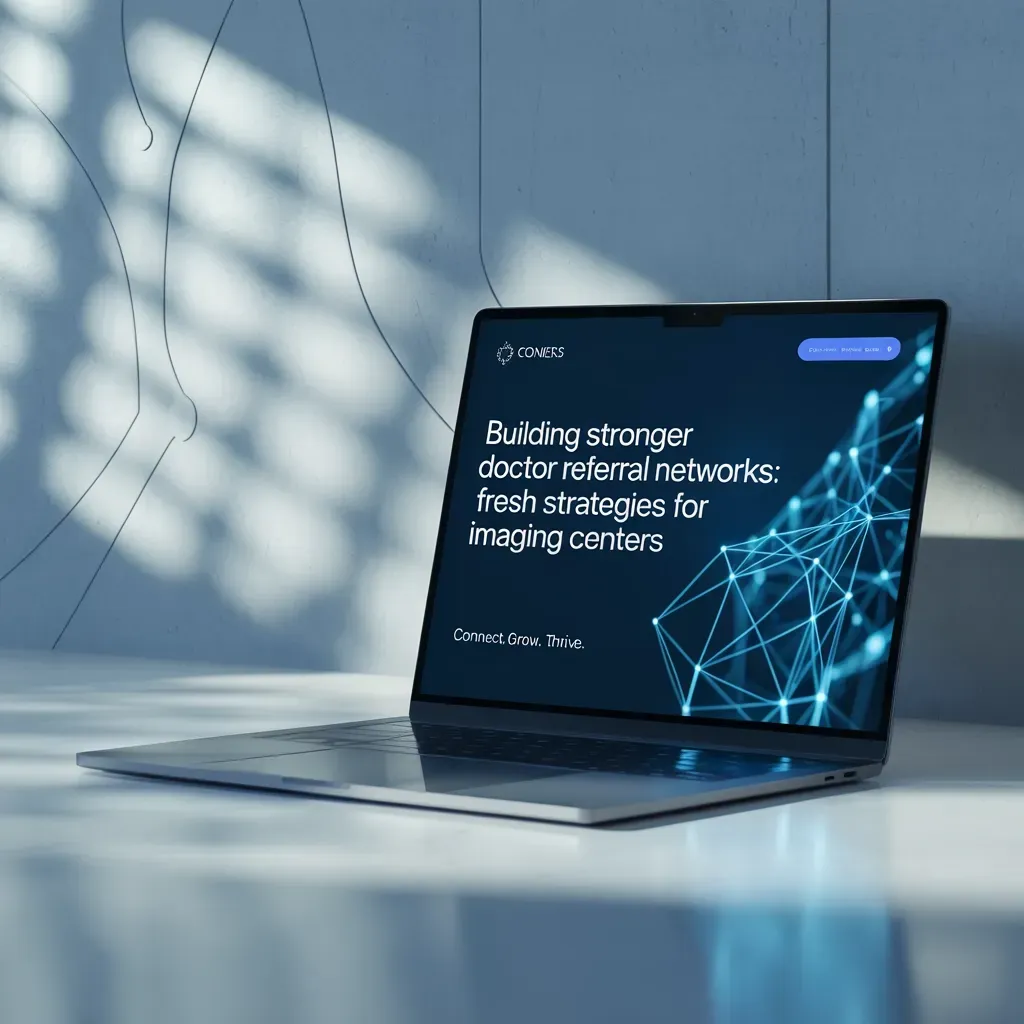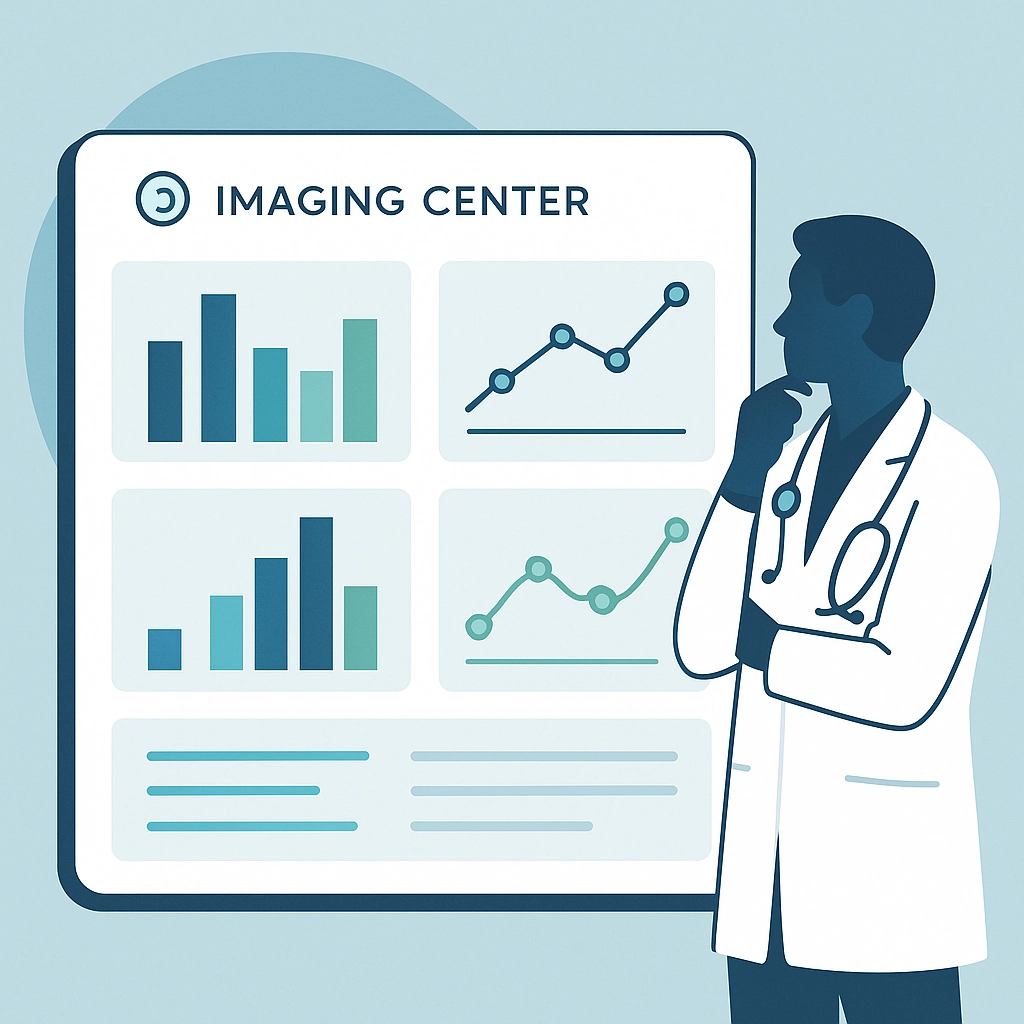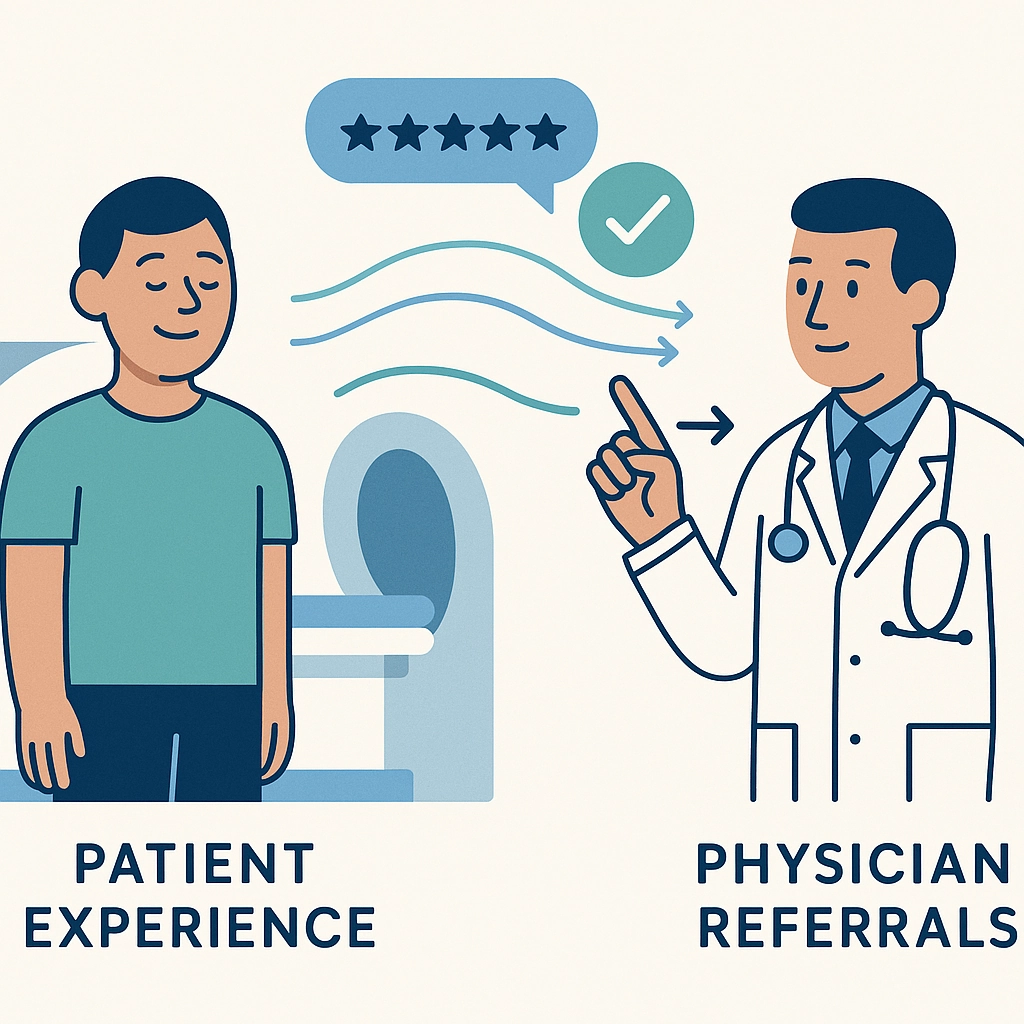
Fresh Strategies for Building Stronger Doctor Referral Networks for Imaging Centers
In today's competitive healthcare landscape, referrals remain the lifeblood of imaging centers. While digital marketing and patient self-referrals are growing, physician referrals still drive 70-80% of appointment volume for most diagnostic imaging facilities. Building and maintaining strong relationships with referring physicians isn't just important—it's essential for survival.
"The strongest imaging centers don't just wait for referrals to come in; they strategically cultivate relationships with referring physicians through consistent communication, exceptional service, and data-driven engagement," says Dr. Michael Reiter, Chief Medical Officer at Northeast Radiology Partners.
Let's explore how imaging centers can modernize their referral development strategies for 2025 and beyond.
The Evolving Referral Landscape
The physician referral process has changed dramatically in recent years. Where relationships once relied primarily on personal connections and occasional lunch visits, today's referring physicians expect:
Digital integration and seamless information exchange
Quick turnaround on reports
Easy scheduling for their patients
Specialized expertise and consultation availability
Evidence of quality outcomes and patient satisfaction
Meanwhile, market consolidation, narrowing insurance networks, and the rise of hospital-owned practices have complicated the referral ecosystem. Imaging centers must adapt their strategies accordingly.
Start with Data: Analyze Your Current Referral Patterns
Before implementing new referral growth strategies, you need a clear picture of your current referral network. This means diving into your data.
Conduct a Comprehensive Referral Analysis
Begin by categorizing your referring physicians by:
Specialty
Location/proximity
Referral volume (high, medium, low)
Referral consistency (steady vs. sporadic)
Types of studies ordered
Insurance/payer mix
Referral trends (growing, stable, or declining)
This analysis will reveal which relationships deserve maintenance efforts and which represent growth opportunities. Many imaging centers discover that 80% of their referrals come from just 20% of their referring physicians—understanding this "vital few" is essential.
"When we analyzed our referral data, we discovered several high-potential referring physicians who were sending us only certain types of studies while sending others to competitors," explains Sarah Jenkins, Director of Business Development at Metro Imaging Associates. "This insight allowed us to have targeted conversations about those specific services, resulting in a 23% increase in referrals from those practices."

Technology Solutions for Referral Relationship Management
Implement a Healthcare-Specific CRM
Generic CRM systems rarely address the unique needs of imaging centers. Consider implementing a healthcare-specific CRM that integrates with your RIS/PACS systems to track referral patterns, physician preferences, and engagement history.
A proper imaging center CRM should offer:
Automated tracking of referral volumes by physician, group, and modality
Communication history logging
Report delivery preferences by physician
Scheduling data integration
Automated alerts for referral pattern changes
Mobile access for business development staff
"When we implemented a specialized healthcare CRM, we gained visibility into referring patterns we never knew existed," notes Tom Wilson, CEO of Western Diagnostic Imaging. "We discovered one large primary care group was sending all their MSK studies to a competitor simply because they didn't know we'd added a dedicated MSK radiologist."
Learn more about why sales automation solutions are important for imaging diagnostic centers to boost referral volumes.
Communication Strategies That Strengthen Physician Relationships
With data in hand and technology to support your efforts, the next step is implementing targeted communication strategies.
Personalized Outreach Based on Physician Preferences
One-size-fits-all approaches no longer work. Modern referral development requires understanding how each physician prefers to interact:
Digital-First Physicians: Younger physicians often prefer email updates, online portals, and text messaging for quick consultations.
Relationship-Focused Physicians: Some physicians value personal connections and prefer in-person visits or phone calls.
Education-Driven Physicians: These doctors value your expertise and appreciate case reviews, journal discussions, and continuing education opportunities.
Operations-Focused Physicians: These practitioners prioritize efficiency and want streamlined workflows, fast turnaround times, and minimal disruption.
By segmenting your referring physicians and tailoring your approach accordingly, you'll see significantly higher engagement rates.
Create Meaningful Educational Content
Position your imaging center as a thought leader by creating valuable content for referring physicians:
Case-based webinars highlighting interesting findings
Monthly clinical newsletters with imaging best practices
Appropriate use criteria guides for different specialties
Brief video explainers of new imaging techniques
Online portal with educational resources
This approach builds credibility while providing genuine value to your referral sources.

Building Bridges with Physician Liaisons
Despite digital advances, the human element remains crucial in referral development. A dedicated physician liaison program can transform your referral relationships.
The Modern Physician Liaison Role
Today's effective physician liaisons are far more than glorified sales representatives. They should:
Have clinical knowledge and understand imaging terminology
Use data analytics to guide outreach priorities
Provide practical solutions to referral workflow challenges
Act as trusted advisors rather than sales people
Serve as the voice of referring physicians within your organization
When hiring physician liaisons, look for individuals who can build relationships based on trust and mutual benefit. Former medical assistants, technologists, or practice managers often excel in these roles due to their understanding of clinical workflows.
Structured Outreach Programs
Effective liaison programs follow structured outreach cycles:
Initial Assessment: Meet with practice managers and physicians to understand their needs, pain points, and referral decision processes.
Customized Solution Presentation: Return with tailored solutions addressing specific challenges identified.
Implementation Support: Help integrate new referral workflows, provide educational materials, or set up digital access.
Regular Check-Ins: Maintain quarterly touchpoints to address new needs, share updates, and strengthen the relationship.
Performance Reviews: Annually review referral patterns with key practices and address any emerging issues.
This systematic approach ensures no relationship falls through the cracks while maximizing the efficiency of your liaison team.
Enhancing the Referrer Experience Through Service Excellence
Your clinical quality is undoubtedly important, but service excellence often drives referral decisions just as powerfully.
Streamline the Referral Process
Remove friction from the referral workflow:
Implement digital referral options (direct EMR integration where possible)
Offer online scheduling for referring offices
Provide transportation assistance for patients when needed
Create dedicated phone lines for referring offices
Develop STAT reading protocols for urgent cases
Prioritize Communication Transparency
Referring physicians consistently cite communication as a top factor in referral decisions:
Provide preliminary results for urgent studies within agreed timeframes
Offer direct radiologist consultation for complex cases
Alert referring offices to significant unexpected findings
Maintain consistent report structures and terminology
Follow physician preferences for report delivery
Learn more about the power of automated patient engagement in radiology practices and how it can complement your referral strategy.
Leveraging Patient Satisfaction to Drive Referrals
While physician relationships drive most referrals, patient experience increasingly influences referral patterns as well.
The Physician-Patient Referral Connection
When patients report positive experiences at your imaging center, referring physicians notice. Conversely, patient complaints about your facility can quickly damage referral relationships.
Implement these strategies to ensure patient experiences reinforce your referral development:
Conduct post-visit patient satisfaction surveys and share positive results with referring offices
Address any negative feedback immediately and inform the referring physician of resolution
Create "physician cards" that patients can return to their referring doctor confirming completion of their imaging
Develop patient education materials that referring physicians can provide in advance
"We discovered that sharing our patient satisfaction scores with referring physicians—especially when they exceeded 95%—significantly influenced their referral decisions," notes Jennifer Moore, Operations Director at Parkview Imaging. "Physicians want to send patients somewhere they know will provide a positive experience."

Differentiation Through Subspecialty Expertise
In crowded markets, subspecialty expertise can be a powerful differentiator. Consider these approaches:
Highlight Your Radiologists' Unique Qualifications
Make your radiologists' subspecialty training and expertise known to referring physicians:
Create subspecialty-specific marketing materials
Organize "meet our expert" events for targeted referring groups
Develop specialty-specific reading protocols with faster turnaround for complex studies
Offer virtual consultations with subspecialty radiologists
Develop Specialty-Specific Referral Programs
Target high-potential specialties with customized programs:
Orthopedics: Implement specialized MSK protocols, offer sports medicine imaging packages, and provide injury-specific reporting templates.
Oncology: Develop tumor board participation, offer expedited scheduling for cancer patients, and implement standardized reporting using LI-RADS, PI-RADS, etc.
Neurology: Create specialized neuroimaging protocols, offer advanced techniques like DTI or perfusion imaging, and provide consistent structured reporting.
OB/GYN: Implement 3D/4D ultrasound services, offer evening/weekend appointments, and develop women's imaging centers with enhanced privacy.
Measuring Success and Optimizing Your Referral Strategy
The most successful imaging centers continuously measure their referral development performance.
Key Performance Indicators for Referral Programs
Track these metrics monthly:
Total referral volume by physician/practice
New referring physicians acquired
Referral retention rate
Referrals by modality
Referral growth rate year-over-year
ROI on liaison activities
Cost per acquired referral
Implement Regular Performance Reviews
Schedule quarterly review meetings with your referral development team to:
Analyze referral trend data
Identify physicians with declining referrals
Evaluate the success of recent initiatives
Adjust resource allocation based on performance
Plan targeted interventions for the next quarter
Learn more about why it's important for imaging diagnostic centers to have a good online reputation to support your referral strategy.
The Future of Imaging Center Referral Networks
Looking ahead, several trends will shape referral development:
Integrated Care Networks
As value-based care expands, imaging centers are increasingly joining clinically integrated networks. These arrangements can stabilize referral volume but require demonstrating quality metrics and cost-effectiveness.
AI-Enhanced Referral Optimization
Artificial intelligence tools are emerging that can predict referral patterns, identify leakage, and recommend targeted interventions. These tools analyze historical data to suggest which physician relationships deserve priority attention.
Teleradiology Integration
Remote reading services are becoming more sophisticated, allowing subspecialty coverage even for smaller imaging centers. This capability can significantly enhance your appeal to specialty practices seeking expert interpretations.
Find out more about how AI-powered marketing is changing for imaging centers and its impact on referral development.
Conclusion: Building Sustainable Referral Growth
Developing strong physician referral networks requires a strategic, data-driven approach combined with exceptional service and meaningful relationships. The most successful imaging centers balance technology solutions with personal connections, creating multiple touchpoints that reinforce their value proposition.
By implementing the strategies outlined in this article—from referral pattern analysis to subspecialty differentiation to structured outreach programs—your imaging center can build more resilient referral networks that withstand competitive pressures and market changes.
Remember that referral development is not a one-time project but an ongoing process requiring consistent attention and refinement. The effort invested in strengthening these relationships delivers substantial returns in volume stability, revenue growth, and market position.
Ready to Transform Your Referral Development Strategy?
Imaging Media Group specializes in helping diagnostic imaging centers build stronger referral networks through customized marketing and relationship management strategies. Our healthcare-specific CRM solutions, physician liaison training programs, and targeted communication tools are designed specifically for imaging centers looking to grow their referral base.
Contact us today to learn how we can help your imaging center develop a more effective, data-driven referral strategy that delivers measurable results.
Still have questions? Want to see how we can help you achieve success? Reach out.
Use the form to the right to reach out to us and speak with a representative, and learn how you can grow your Imaging Center.
Let's Chat
Contact Us
© 2025 Imaging Media Group - All Rights Reserved
Imaging Media Group and SalesPilot CRM are divisions of Mixed Media Ventures

